This week’s format is the most direct format we’ve seen so far in the Star Realms Arena. The Scenario card’s rule is as simple as it can get: Once per turn each player may spend 1 trade to gain 3 combat. The complexity comes not in the rule, but in the effect of the rule. Playing this Scenario well requires knowledge of the Colony Wars deck, the flow of the game, and of the expected meta. In this week’s article, I break down what worked for me and what didn’t, and as always I’ll give the data that you can use to stay one step ahead.
Route One: Aggro
This week uses Colony Wars, which is seen by many to be a faster format than “Vanilla” (aka the Star Realms Base Game). Colony Wars features several cards that go into your hand when you purchase them. It also features several common and uncommon cards that generate 3 trade. This tends to bring games to an explosive conclusion two or three turns faster than in Vanilla.
With the Scenario, you can knock off an additional two turns. Assuming both players go full aggro, games can end on turns 14-16 on average. That’s 7 or 8 turns per player – you might not even shuffle a third time!
Players are avoiding scrapping cards, and that is pretty smart. Deck scrapping is not that powerful when you are shuffling only two or three times. Players are also avoiding bases, because they are extremely likely to be destroyed as soon as your opponent begins their turn. As most bases are costed to assume they have a survival chance, buying bases is usually not the best play.
Most people are going to chase after the Star Empire and Blob cards that deal damage quickly. Ravager is a great card in this all-aggro format, both because of the damage it deals and because of the trade row-control it provides. Since most people are not building towards a late game, it is possible to deny any viable purchase options by scrapping low-cost cards from the trade row. It is possible to force your opponent to buy no cards at all this way. You can do this in the midgame, and it is usually backbreaking!
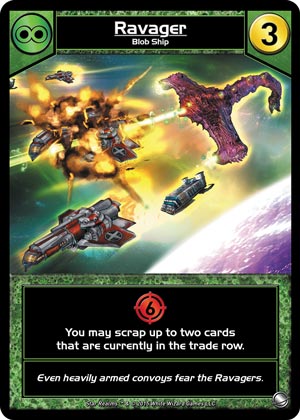
Because this format leads to an aggro state faster than normal, most people will choose quick damage as their primary option. To borrow a phrase from soccer, this is “Route One” as it is the obvious go-to. Most of the Scenarios do not point people to a particular strategy quite like this one does. How do we take advantage of this meta? Absorb the damage and fight back big.
Absorb and Respond
If everyone is bringing rocks to the fight, it is time to play paper. In this case, paper is authority-gain. While the bases in Colony Wars are priced assuming multiple uses, the authority gain cards are still available at a reasonable price. (No, there is no Cutter, but Trade Hauler isn’t too bad.) In fact, the Trade Federation was my main route to victory. Almost no one went for it, assuming that Route One was the only way.
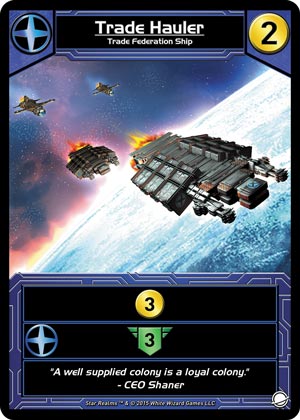

In all seven of my games, the player with the most authority-gain won.
- Game 1: Win on turn 23 with 48 authority remaining. Scrapping, small-cost ships for damage, and Trade Federation for money and authority
- Game 2: Win on turn 15 with 21 authority remaining. Blob and Trade Federation. Damage and authority-gain with the extra money ensuring I would use the scenario every turn.
- Game 3: Win on turn 17 with 12 authority remaining. Trade Federation and cheap damage cards. The authority gain was the difference, again.
- Game 4: Win on turn 18 with 39 authority remaining. I purchased every Star Empire card that appeared in the trade row, including three Orbital Platforms. Those bases are worth it in this format if you can ally reliably.
- Game 5: Win on turn 31 with 2 authority remaining, as my opponent’s deck betrayed them at the end. I must have gained 40 authority during this game!
- Game 6: Lost on turn 19 with my opponent having 17 authority remaining. I was baited into an all-aggro strategy when there were other options available and I turned the game into a coinflip. I lost the flip.
- Game 7: Won on turn 14 with 5 authority remaining. Turn one Gunship was the only real option on the trade row. My opponent then started to build a Trade Federation-based stall deck but didn’t get the ally triggers he needed. I went into discard and damage, what Star Empire can do quite well in Colony Wars. I don’t suggest this style, but sometimes you have to make the best of a bad situation.
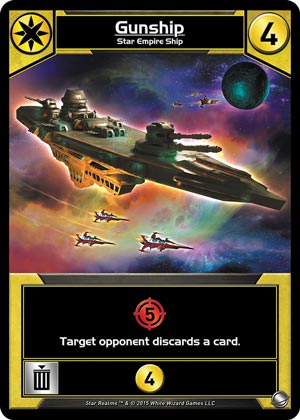
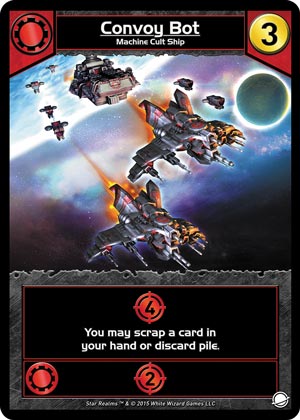
Because you can construct a deck that is designed to go long, you should not ignore the deck-scrapping cards. Good news! Most of the time, your opponents are ignoring them! (Convoy Bot is snap-purchased, but most of the others are not.) There are many common cards in both red and blue that set this strategy up. Don’t be afraid to buy one or two Blob cards to control the trade row along the way. Again, this strategy depends on smart play that leads to a long game. A Blob card to deny a great card from your opponent might make the difference between a failed midgame and a winning late game.
Conclusion
Arena continues to reward smart analysis more than normal games, where you can rely on months or years of experience to guide you to some easier wins against newer opponents. We’re all new, each and every week.
From what I have seen, it seems like the player that uses the Scenario card wins the most. But that doesn’t mean to use it every turn!
I went 6-1 in my first run this week and I am well on my way to more arena stars by the time you read this. I started 5-0, and my one loss came from abandoning the strategies I listed above. Just because the format looks fast on the surface, doesn’t mean there isn’t depth underneath. Most people assume aggro is the main way, or the ONLY way, and that just isn’t the case. Midrange and control decks are still possible, but you need to make use of new tools to succeed.
Good luck getting that shiny!
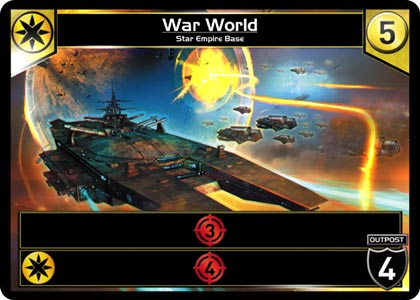


Recent Comments